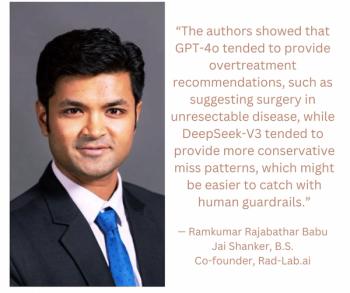
Deep Learning Helps Predict Y90-RE Response in HCC Patients
Using a deep convolutional neural network can improve providers’ ability to predict how patients with hepatocellular carcinoma will respond to Y90-RE treatment, enabling them to offer additional therapies, if necessary.
Providers can do a better job of predicting how patients with hepatocellular cancer (HCC) will respond to Yttrium-90 radioembolization (Y90-RE) treatment when they use a deep convolutional neural network (DNN).
In a poster presented during the Society for Imaging Informatics in Medicine (SIIM) 2021 Virtual Annual Meeting, William Wagstaff, M.D., MS, a third-year radiology and imaging sciences resident at Emory University School of Medicine, revealed that applying the algorithm improved the ability to determine how a patient will respond to Y90-RE therapy.
“The deep learning algorithm had a 16-percent higher area under the receiver operating characteristic curve (ROC-AUC) for predicting immediate, post-radioembolization treatment response in patients with HCC compared to the current best method,” he explained. “This algorithm has the potential to highlight patients that may benefit from earlier follow-up or additional therapy.
For more coverage of SIIM 2021, click
Only a small number of patients with HCC qualify for curative surgery or transplant, so Y90-RE is the alternative treatment method. However, a patient’s response to Y90-RE is assessed via imaging after three-to-six months, potentially giving the tumor time to progress or metastasize. To find out whether using a DNN could help providers predict a patient’s Y90-RE response, Wagstaff’s team conducted a retrospective analysis on HCC patients who received Y90-RE treatment between December 2014 and January 2019 at a single institution.
For their study, they divided 77 patients with a total of 103 lesions who had no prior Y90-RE therapy into two groups – 57 with complete response to treatment and 46 with incomplete response. They hand-segmented lesions on pre-treatment arterial phase MRI to pinpoint lesion location, as well as on post-treatment arterial phase MRI to determine slice-wise response, and they used immediate post-Y90-RE SPECT as a proxy for treatment area and dose. Ninety percent of lesions were in a training set, and 10 percent were part of a hold-out test set.
Based on their analysis, the five-fold cross-validation results for the ensemble model were sensitivity of 0.73 +/- 0.29, specificity of 0.70 +/- 0.14, accuracy of 0.75 +/- 0.09, and ROC-AUC of 0.79 +/- 0.12. By comparison, the partition model had a sensitivity of 0.36 +/- 0.34, specificity of 0.80 +/- 0.40, accuracy of 0.63 +/- 0.04, and ROC-AUC of 0.62 +/- 0.09.
In addition, test set results for the ensemble model were sensitivity 0.32, specificity 0.85, accuracy 0.65, and ROC-AUC 0.66, and the results for the partition model were sensitivity 0.03, specificity 0.99, accuracy 0.62, and ROC-AUC 0.57.
For more coverage based on industry expert insights and research, subscribe to the Diagnostic Imaging e-newsletter here .
Newsletter
Stay at the forefront of radiology with the Diagnostic Imaging newsletter, delivering the latest news, clinical insights, and imaging advancements for today’s radiologists.




























